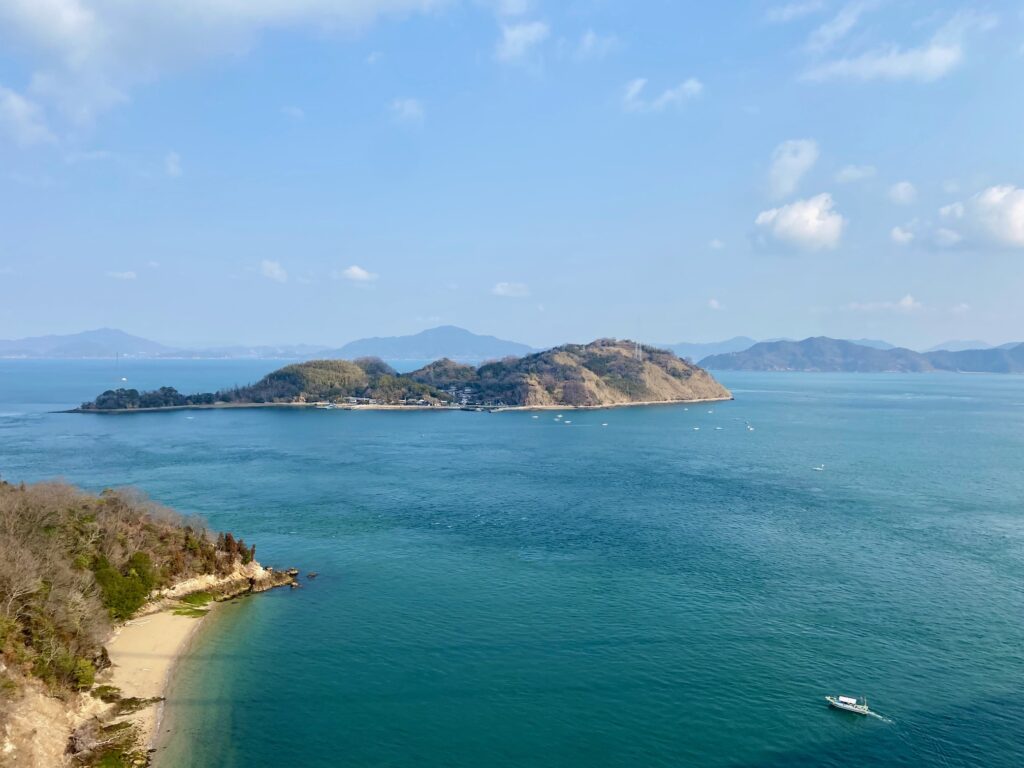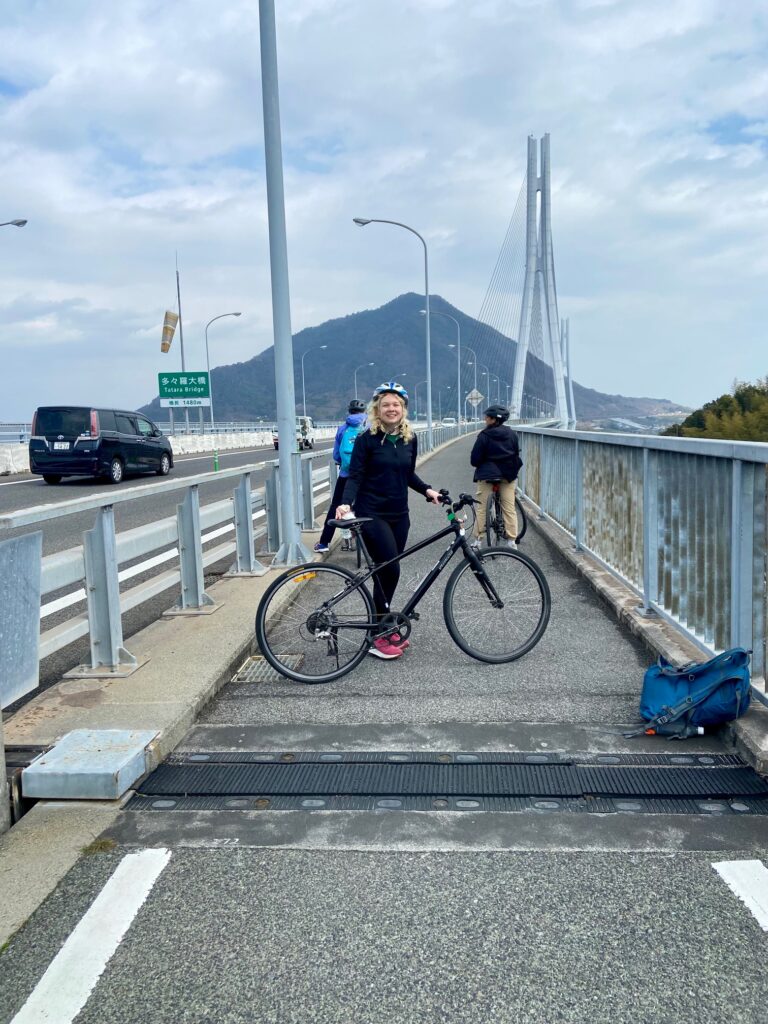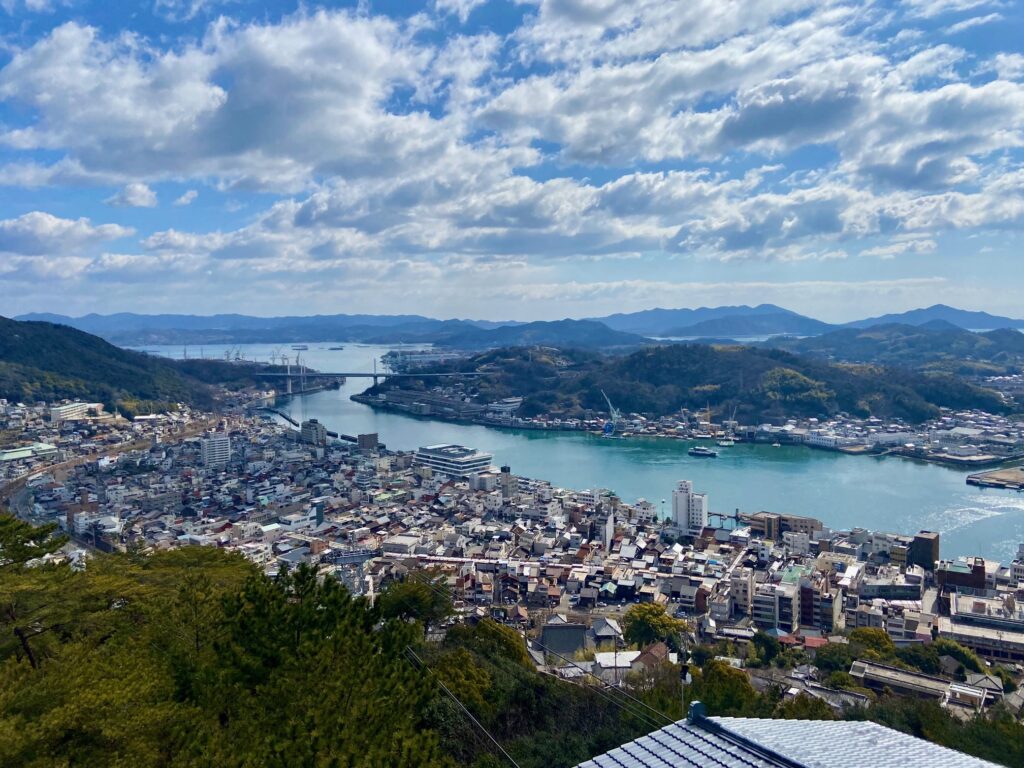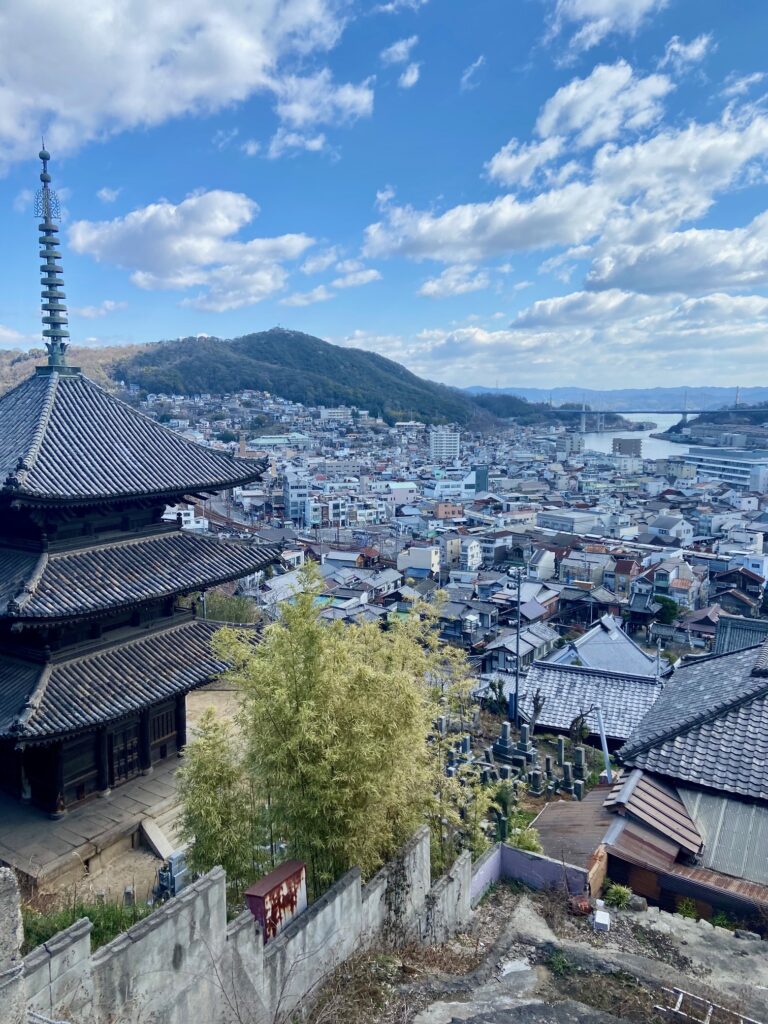No training? No problem! A trek for all, from amateurs to athletes
This article was originally featured in the April 2024 issue of Connect.
Chloe Holm (Tokyo)
What is the Shimanami Kaido?
Japan’s 70 km (43 mi) world-famous, island-hopping bike route is a cyclist’s best dream and worst nightmare.
Stretching across the Seto Naikai Islands and spanning across two prefectures (Ehime and Hiroshima), it’s the perfect way to enjoy and explore the countryside while still completing a feat comparable to climbing Mount Fuji!
The Shimanami Kaido translates literally to “the road of islands and waves,” and this is a pretty accurate description of the cycling route: the path takes you parallel to the Nishi Seto Expressway that connects the small offshoot island Shikoku to its larger, neighboring mainland island Honshu. Built in 1999, the route’s bridges are some of the first and longest cable-stayed bridges in the world. The route is even used as a rite of passage for young teens that walk a stretch of the path to commemorate their 20th birthday! Despite its proximity to the expressway, the biking path follows a winding up-and-down countryside path and the route is very conveniently marked out with a blue line on the road, guiding cyclists the whole way!

Who can (realistically) make the trek?
Anyone! Despite the distance being equivalent to a round-trip hike around the Grand Canyon, the trek can be completed by new cyclists, although a bit of training is preferable to complete the course in one day. With a total of six large hills over the span of 70 km, new cyclists may experience fatigue. Fortunately, buses are available to take you the rest of the way if you have to stop halfway through—just make sure to return your rental bike at one of the numerous rental terminals along the route as bikes cannot be loaded onto buses.

What is the route like?
Expect lots of hills, lots of cyclists, and stunning views.
Despite the Shimanami Kaido following along a major expressway, the cycling route meanders around the islands that dot the connecting Seto Inland sea. It enfolds stunning views of the sea, islands, and many citrus trees the area is famous for. With the popularity of this route, many Imabari and Onomichi locals frequent this cycling path for a weekend outing. Plan accordingly for lots of cycling traffic and pace yourself for the hills—the first few may seem easy enough, but make sure to not run out of steam by hill five or six.

When is the best time to bike?
Summer might bring stunning views of the Seto Inland Sea and islands surrounding the gorgeous path, but with temperatures ranging in the mid 30s Celsius (high 90s Fahrenheit), an extensive day of biking might be too much to handle. Instead, consider spring or fall, as the weather is milder but the sights still bloom with the abundance of natural beauty Shikoku is known for. Just try to avoid the monsoon season, if possible (from September to October).

How long will it take?
The journey can take anywhere from 8-12 hours, depending on rests and fitness levels. An experienced cyclist may complete it in as little as six hours, but plan for a full day dedicated to cycling.

I’m concerned about my fitness level. Can I complete it?
This 43-mile bike path can definitely seem intimidating, but most new cyclists are able to complete it with a bit of help! Consider stopping halfway to take a bus the rest of the way, renting an e-bike (electric bike) for an easier time on your knees and an extra boost up hills, or even spending the night on one of the islands and finishing the route in the morning! The main cycling path is full of ups and downs and hilly twists and turns, but there are plenty of flat stretches to give your legs a bit of a much-needed reprieve. With these modifications, most concerned cyclists can muster up the courage to complete this trek across Japan in one piece!

I don’t have any equipment. What about bike rentals?
For new cyclists or bikers without their own equipment, there are many rental options before beginning the trek. When choosing a bike to rent, there are three different types to consider:
- City bikes (cross bikes): The most accessible (and cheapest) bike to rent for this trek, these bikes typically have between one and three set speeds, so be warned that hills will be tougher without the ability to change speeds.
- Road bikes: These standard 10-speed bikes are simple enough for most riders to operate but also have the range for increased horsepower and speed to help you crest the trail’s many hills.
- Electric bikes: If you feel you might need extra help on the journey, consider renting an electric bike. This will make it easier on your legs and speed up your trip, but it’ll be more expensive.

What’s a good route to take?
7 a.m.: Head for Imabari Port, Ehime, taking JR limited express lines to the small port city. The route is doable in one day, but there are also local bed-and-breakfast options on the islands, so you can spend the night, rejuvenate, and be ready to finish strong the next day. Get an early start on the route as the buses stop running on the route around 5 p.m. and you will want to make it to the end (or lodging) before dark!
With that being said, as the biking route is such a big excursion, I recommend staying at a local hostel or hotel near Imabari to get a good night’s rest before beginning the route in the morning. There are many budget friendly options, including biking hostels and business hotels where you might meet other cyclists!
9 a.m.: Rent bikes from either Sunrise Itoyama or Giant Store. It’s about a 20- to 30-minute bike ride to the starting point of the Shimanami Kaido, so this little warm up will be perfect to limber up your legs before beginning the trek.
9:30 a.m.: Begin the bike trek and climb the world’s first triple suspension bridge to the islet Oshima. Enjoy the amazing views for the start of your journey!
11 a.m.: Take a break at a roadside convenience spot for drinks, snacks, and a gorgeous view from the first island Oshima.
12 p.m.: Stop for lunch at one of the many convenience stores on island two, Hatakatocho, or the larger third island, Omishima. The third island has some stunning shrines (and some of the oldest in Japan) to visit as well if you have spare time.
2 p.m.: Continue on to island four, Kuchi Island, and make sure to take a picture crossing from Ehime Prefecture into Hiroshima Prefecture on the connecting Ikuchi Suspension bridge!
3 p.m.: Stop to enjoy the abundant citrus trees on the fifth island of Innoshima and for a quick photo shoot with the white dinosaur that marks one more island to go!
5 p.m.: Reach the final island of Mukaishima and congratulate yourself! Return rental bikes and take a bus into the town of Onomichi to enjoy a well-deserved bowl of Onomichi ramen and some rest.
After crossing the six islands of the Seto Inland Sea, congrats! You’ve made it to mainland Japan, and the quaint coastal town of Onomichi.

What can I do in Onomichi?
With a population of about 130,000, it’s a small town in Hiroshima Prefecture, famous for citrus and cats. Thanks to its proximity to the cycling route, there are plenty of souvenir shops in the town where you can buy T-shirts, mugs, and memorabilia to commemorate your cycling efforts!
- Temple walk: If you have a day here, there’s a beautiful path that leads you around to all the local temples which look out over the Seto Inland Sea. If short on time, prioritize Senkoji Temple: the observatory offers stunning views of the sea and a short Literature Walk commemorating famous Japanese poets and authors.
- Cat alley: A collection of alleyways along the temple walk host cat-themed artworks and decorations and many stray kitties are known to roam the area.
- Ropeway and overlook: From this vantage point, you can actually trace your biking path with the white suspension bridges and get a bird’s-eye view of the mountains you cycled over!

Any other advice?
- Keep it slow and steady: The path is a marathon, not a sprint. Your body will thank you the next day (or week) for taking it slow!
- Add an extra cush for your tush: If you’re renting bikes en route, keep in mind the seats are hard plastic ones and the route has many bumpy hills; your bottom will thank you for the extra padding!
- Layers, layers, layers: Even in the heat, the wind chill and outdoors exposure can cause body temperatures to drop rapidly; prepare extra layers, especially for your hands, face, and butt!
- Bring extra water and sunscreen: The sun exposure is no joke on this cycling path; extra hydration and sun protection is a must.
- Eat and rest at convenience stores: For a quick energy boost, stop at the convenience stores that dot the trek. It’s much quicker than sitting down at a restaurant and they’ll have plenty of food, drinks, and sun protection!

And that’s it! Whether you’re a seasoned cyclist or just beginning your newfound passion for cycling, the Shimanami Kaido is sure to delight and astound both experienced and new adventure seekers everywhere.
Chloe Holm is an Ehime JET alumni from Ohio who is now working as a professor in Tokyo. She loves keeping up with the latest movies, shows, and pop culture trends in Tokyo and abroad. When she’s not writing or teaching, she’s always on the hunt for a new book and to find the best coffee in the city.




